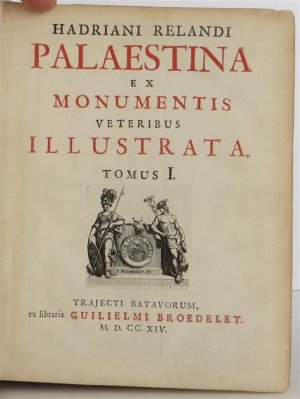A friend sent this to me the other day. It is an interesting read about a book that was written in 1695 about Palestine. I looking for an English translation from Latin to read.
View attachment 311206
HISTORICAL FACT: Palestine in the 1600s
The book completely refutes theories about "Palestinian traditions,” to the "Palestinian people" and has almost no link between the land and the Arabs
The author Adriani Rilandi is a geographer, cartographer, traveler, philologist, he knew several European languages, Arabic, ancient Greek, Hebrew. The book is written in Latin. In the year 1695. Rilandi was describing what was then called Palestine.° .
THERE IS AN OLD BOOK "PALESTINA EX” MONUMENTIS VETERIBUS ILLUSTRATA"
The author Adriani Rilandi is a geographer, cartographer, traveler, philologist, he knew several European languages, Arabic, ancient Greek, Hebrew. The book is written in Latin in the year 1695. Rilandi was describing what was then called Palestine. He visited almost 2,500 settlements mentioned in the Bible. The research was conducted as follows:
*He first created the map of Palestine. He then designated every settlement mentioned in the Bible or the Talmud with its original name.
* If the original was Jewish, it meant "pasuk" (sentence in the Holy Scriptures, which mentions the name).
* If the original was Roman or Greek, the connection was in Latin or Greek. In the end, he made a population census by settlements.
HERE ARE THE MAIN CONCLUSIONS AND SOME FACTS:
* The country is mainly empty, abandoned, sparsely populated, the main population in Jerusalem, Akko, Tsfat, Jaffa, Tveria and Gaza.
* Most of the population is Jews, almost everyone else is Christians, very few Muslims, mostly Bedouins.
*The only exception is Nablus (now)Schem), in which approximately 120 people from the Muslim family Natsha lived and approximately 70 "shomronim" (Samaritans).
* In Nazareth, the capital of Galilee, lived approximately 700 people - all Christians.
* In Jerusalem - about 5000 people, almost all Jews and a few Christians.
* In 1695, everyone knew that the origin of the country was Jewish.
* There is not a single settlement in Palestine that has Arabic roots in its name.
* Most settlements have Jewish originals, and in some cases Greek or Roman Latin.
* Apart from the city of Ramla, there is no Arabic settlement that has an original Arabic name. Jewish, Greek or Latin names that have been changed to Arabic that don't make any sense in Arabic.
In Arabic, names like Akko, Haifa, Jaffa, Nablus, Gaza or Jenin do not make any sense, and names like Ramallah, al-Khalil (Hebron), al-Quds (Jerusalem) do not have philological or historical Arabic roots.
So, for example, in 1696, Ramallah was called Bethel (Beit El, the House of God), Hebron was called Hebron and the Cave of Mahpel was called El-Khalil (the nickname of Abraham) by the Arabs.
* Relandi mentions Muslims only as nomadic Bedouins who came to the cities as seasonal workers in agriculture or construction.
* About 550 people lived in Gaza, half of them Jews and half Christians. Jews were successful in agriculture, especially in vineyards, olives and wheat, Christians were trading and by transportation.
* Jews lived in Tveria and Tsfat, but their occupation is not mentioned, except for the traditional fishing in Kineret.
* In the village of Um El Fahm, for example, lived 10 families, all Christians (about 50 people). There stood a small Maronite church. The book completely refutes theories about "Palestinian traditions," to the "Palestinian people" and has almost no link between the land and the Arabs, who even stole the Latin name of the land (Palestine) and took it for themselves.
Discovered by: Yuri Sobolev


